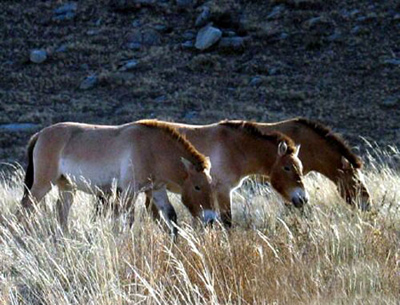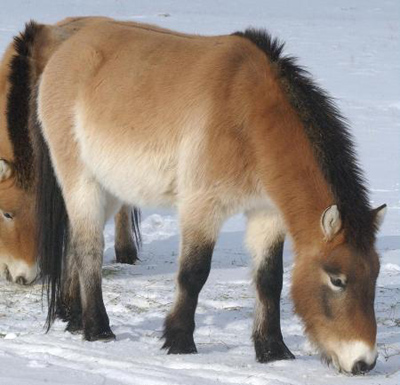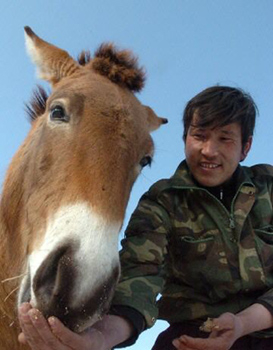Returning Home—Przewalski's Horse Reintroduction Project
In 1966 people last saw the Przewalski's horses in the wild. Since then, this rare species, commonly known as the wild horse, can be found only in zoos. The Przewalski's Horse Reintroduction Project of China was initiated in 1985 when the country introduced 11 wild horses from overseas. After more than two decades of dedicated efforts, the Xinjiang Wild Horse Breeding Center managed to breed a large number of the horses, of which 55 were let loose into the Kalamely Mountain area, a place where their ancestors once roamed freely.
Reintroduction
When the journalist stepped over the fence, all the horses stopped grazing and raised their heads cautiously. While the rest stood still, the dominant stallion circled the herd to mark his territory. When the journalist tried to get nearer, the whole herd, led by the dominant stallion, whirled and broke into a fast gallop along the fence, causing flakes of snow to fly all about.
The Xinjiang Wild Horse Breeding Center is some 60 kilometers from Gymsar Town. When the journalist arrived, all 117 Przewalski's horses bred here had just recovered from a serious disease. In the past, the center's staff attended the animals carefully. None of them relaxed until they had made sure all the horses were completely restored to health.
The last Przewalski's horse was last sighted in the wild in 1966. Since then international organizations have been working hard to save the rare species. "Currently there are no more than 2,000 such horses around the world. In this sense, this species is even more precious than the giant panda," explained Cao Jie, director of the breeding center.
Horses reintroduced into the wild are now reproducing slowly due to their long captivity. Although the original intention was to protect the animals from extinction, artificial breeding has caused a drastic decline in the horses' physical strength and their power to resist diseases. Given these facts, specialists around the globe have agreed that the best way to sustain the species was to reintroduce them into the wild.
In the 1980s, the reintroduction program kicked off in Mongolia and China's Xinjiang Uygur Autonomous Region. The two countries, however, differ widely in their methods of freeing the animals. In Mongolia, horses are released into the wild immediately after they are imported from foreign zoos. When a horse is found dead, authorities will import another one in order to replenish the herd. Requiring high capital, this method can't maintain stable population growth and such a small group of horses have great difficulty surviving in the wild. In comparison, Chinese experts free the horses only after they have multiplied into a relatively large herd inside the breeding center. "Our original plan was to free the horses when the herd reached 80 head," explained a staff member.
Some 160 kilometers away from Urumqi, the center is a three-story blue building 15 kilometers off an expressway. There are a total of 12 stables. Each is home to a family group of horses. Next to the stables is a fenced pasture covering 200 hectares. All horses remain in the pasture to acclimate to the wild before they are finally released.
At the first glance, wild horses are easily mistaken for donkeys, but a wild horse has a smaller head and shorter ears. Its tail is loose but not as long as that of the domesticated horse. Wild horses are usually strongly built and an adult stands some 1.5 meters high. They command an obvious advantage when fighting with domesticated horses, because horses tend to bite their rival's forelegs, and the smaller body of the wild horse means quicker maneuvers. The coat of wild horses is predominantly light brown but it darkens in the summer. In the wild, it is difficult to approach a wild horse because the highly vigilant animal will run away when it is still hundreds of meters away from human beings. Unlike domesticated horses, the manes of wild horses are extremely short and stand straight up as if they have just been given a crew cut.
When two wild horses help each other with grooming, they stand close together head to tail and stretch their heads over each other's bodies while nipping softly. When one horse changes position, the other will change correspondingly. When a group of wild horses stand at rest, they will group together in a circle with their heads clustering in the middle. The dominant stallion usually positions himself in the center of the circle, keeping alert for unusual sounds. This is the best way for the wild horses to protect themselves. When under attack, they will kick the enemy forcefully with their hooves.
The breeding center covers a total area of 600 hectares, most of which, unfortunately, lies upon alkaline land that does not support vegetation and is unsuitable for farming. "We hope one day we can plant grass on this land and let the horses to eat by themselves. Currently, we feed the horses four times a day. We have tried to replenish patches of land with better soil to grow natural grasses but it was not cost effective."
Fortunately, the imported wild horses quickly adapted to their new environment. In 1988, six foals were born and survived. This indicated that the animals had managed to overcome breeding difficulties in this semiarid region. "In 2001, when we were about to release some horses into the wild, there were over 100 horses at the center. Now both their reproduction rate and survival rate are the highest in the world. Moreover, the parasites that used to trouble them in foreign countries have never been found here. Perhaps because they have returned to their ancestral home," said Cao Jie proudly.
Hard return
To release the horses into the wild is the final aim of the reintroduction program. However, the return was realized only after Honghua, the first horse born at the center, died in an accident.
"The wild horses are physically mature at the age of three, but they are sexually mature at two. If a mare gets pregnant when not fully grown up, she is prone to abortion," explained Yan Hui, a technician at the center. When Honghua entered breeding age, she was the fattest mare at the center. "When a mare's udders hang heavy and turgid, with milk dripping out, an experienced breeder knows she will give birth in hours or at most in a day." Honghua had successfully borne five foals before, but on May 13, 2000, when it was her time to give birth to her sixth one, she experienced difficulties with the delivery. When a specialist finally arrived at the center from hundreds of miles away, part of the mare's intestines had slipped out of her body. A staff worker tried to anaesthetize her with a special rifle, but the mare got startled and began to gallop. The unfortunate animal only ran a few meters before treading upon her own intestines and dying. After Honghua's tragedy, the specialist conducted an investigation and concluded that the mare's difficult delivery was due to obesity. She got too fat due to her long period of captivity and insufficient physical exercise. Her tragedy pushed forward the agenda of the return to the wild plan for the horses. And, as a matter of fact, the horse population had surpassed 80 a long time ago, but their release had been delayed over and over due to a lack of funds.
The first group of the Przewalski's horses was set free in the Kalamely Mountain area, where the ancient wild horses had originally lived and multiplied. Some 40 kilometers from Charcurt Town and 310 kilometers down the National Highway No. 216, staff members of the breeding center constructed a small white house to monitor the conditions of the horses. Next to the house, they created a fenced pasture covering four square kilometers. On August 8, 2001, the first group of 27 horses arrived and lived inside the pasture for 20 days before they finally went into the wild. "Initially, we wanted to choose horses with distant family relations. But taking into account that these animals are gregarious with strong hostility towards newcomers, we selected out a family group to ensure the herd's stability. In the beginning, we chose 21 horses, including one stallion and seven mares. But six more foals were born inside the fenced pasture. This notched the total number up to 27," recalled Wang Zhenshan, a five-year veteran worker at the Charcurt Monitoring Station.
Plants were abundant inside the fenced pasture, but the wild horses were unaccustomed to water with high alkaline content. In the beginning, they drank frequently every day but sipped water in extremely small amounts each time. To help the horses get used to the water, station staff went to the Urum River to fetch purer water. On the first day, they added one share of the river water into one share of local water, and in the following days, they diminished the portion of river water gradually until the horses finally got used to the local conditions.
At 9:00 AM, August 28, 2001, 27 wild horses, led by the dominant stallion called Dashuai, galloped off northwestwards toward the large mountain. Half an hour later, the staff members set out to find the horses, but they discovered nothing and themselves got lost in the darkness. Fortunately, the horses came back by themselves the next morning. "When they galloped back along National Highway No. 216, we traced their journey by following their hoof prints. These horses had run some 50 kilometers during the night," exclaimed Wang Zhenshan.
Since then, Wang had to get up at 7:00 every day to trace the horses and monitor their conditions. When he came back, it was usually late at night. "After a few days, I had a few insights. There are three things to notice when tracking horses: the water source, horse dung and hoof prints. The hoof print of the wild horse is heart shaped. When I find these tracks, I will first figure out whether there is a water source in the neighborhood. If there is one, I will go there to wait for the horses because sooner or later, they will come to drink water. Also, I will observe the dung. If it's still fresh, the horses must have been there not long ago," Wang Zhenshan explained.
Wild horses tend to migrate between water sources around Kalamely Mountain. "There used to be many seasonal water sources around Kalamely Mountain, but in recent years, this region has suffered a long drought and lots of the water sources have vanished. Today, there are, at most, 40 to 50 fixed water sources. Of them, only a little over 10 are suitable for drinking. We will be fully confident of the horses' survival in the wild only when they find permanent water sources, which means that they would have regular places to live through the winter and places to graze during the summer," said the station's director Wang Chen.
In addition to water sources, domesticated horses also pose a major threat to the wild horses. In the Altay Prefecture, herdsmen of the Kazak Ethnic Group migrate to the Wucaiwan Winter Pasture every year. Their livestock will eat up all the grass when passing through Charcurt Town. And up to now, the greatest fear of the station staff is that the Kazak domesticated horses may breed with the Przewalski's horses, create hybrids, and badly affect their gene pool.
Shortage of financial aid
The breeding center started to release the horses into a semi-wild environment beginning in the winter of 2001. Frightened by nomadic herdsmen, the herd of horses ran into the wilds of Kalamely Mountain. The thick snow threatened the horses' lives and hindered the center's search operation. After twenty days of great effort, the search team finally located the lost horses. They found the dominant stallion exhausted and the mare expected to play the role of "queen" missing. The dominant stallion died shortly after he was returned to the fenced pasture.
The center then imported another two stallions to fill the gap of the former leaders. The two newcomers each vied for several female partners and split apart the original herd. Generally, the optimized number for a herd consists of one male horse and five to seven female ones.
Then, in order to keep the blood pure, the new stallions killed all the foals born the next spring by biting them to death. Finally, in the spring of 2003, upon the birth of the new leaders' offspring, the horses crossed the threshold toward survival and reproduction in the wild.
According to the center staff, wild mares usually give birth from May to August and enter heat one week after giving birth. The pregnancy period lasts about 340 days. Since winters are critical times for pregnant horses, the center keeps the horses in captivity to prevent them from disturbing herdsmen. To mimic the natural environment, the center scatters bundles of hay inside the fence and forces the horses to discover food covered by the heavy snow. Such measures also keep wild horses from human contact and cultivate their alertness.
After leaving the fenced pasture, wild horses will sometimes stop by their "old homes". Sometimes, they even return to the permanent water source during dry season.
"One of the new groups released this year left the fenced pasture last May and reappeared in September of this year," said Wang Chen.
Six years from the first release, the second and the third generation of the horses have indeed managed to survive in the Kalamely Mountain areas. They have learned to forage for food and water and fight against enemies.
"We urged a wolfhound to attack the horse drove. The dominant stallion organized a fan-shaped battle formation immediately with the strong horses in the front and the weak ones behind," said Wang Zhenshan. "The stallion, standing in front, fought against the hound with its hooves. When we managed to pull the hound out of the battle, it was at its last gasp. These wild horses are capable of protecting themselves from wolf attacks."
However, the ultimate goal lays in the offspring of the first batch of wild horses released into the natural environment. "We hope their offspring can adapt to the wild environment," said Wang Chen, adding that since the wild horses can reproduce in the wildness, they are considered able to survive.
In contrast to their success with wild horse cultivation, the center failed to make financial ends meet. The expense in 2006 was 1.7 million yuan (about US$2.3 million), 6 million (about US$0.81 million) more than the fund earmarked by the central government. The tight budget has driven away dozens of employees. A total of 17 regular employees and 10 part-timers work at the center. Some 100 people have worked there, but few of them have stayed for more than 15 years. "The average salary of a regular employee is 1,300 to 1,400 yuan (about US$177 to 190) and a part-timer only 700 yuan (about US$95)," explained Director Cao. "Four workers now have to cover the work used to be done by the six to feed the horses."
The working and living conditions are so harsh that many people have balked and left. They had to dig wells by themselves and relied on diesel electric generators until 2002 when they ran an electric cable from a nearby herdsmen's settlement with the aid of a governmental subsidy.
The nearest township is approximate 20 kilometers away from the center. The workers have to cycle to the post office there to make a phone call and keep touch with their families. The center has two rows of single-story houses for use as dormitories; the horse stables are directly behind them. A three-story building was erected in 2003 to improve living conditions, but the money for construction left the center officials scratching their heads.
The government allocated funds based on 76 horses. But now more than 170 horses, raised in captivity and in the wild, exist. The nationwide price hike has also hit this remote area, with the price of hay nearly doubling up to one yuan (14 US cents) per kilogram. In the past, the center would prepare special feed for stallions before the breeding season. But some nutritious ingredients, such as barley, bran and eggs have been crossed off the menu due to soaring prices.
Last year, America gave three GPS neckbands to the center as a gift, which saved the center manpower and time to search for the wild horses. However, the new technology is far from popular due to the shortage of money. "We only use the electric neckbands from 9 AM to 6 PM so as to prolong their service life because one such neckband costs US$5,000," said Wang Chen.
The movement of Kazak herdsmen has had the greatest influence on the wild horses' lives. Although the government has helped the nomadic ethnic minority to settle down, it is difficult to change a people's life style in a short period of time. "It takes a lot of money and time to do surveys on herdsmen's living habits and conditions as well as map out a feasible relocation plan," said Cao Jie, the director.
(China.org.cn by Chen Xia, Huang Shan, December 28, 2007)









